The essential attributes of comfortable living are the benefits of civilization familiar to a person, such as ergonomic furniture, stable water supply, properly planned lighting and plumbing that works without interruption. The correct operation of all the listed equipment is taken for granted, and a breakdown almost always comes as a surprise, bringing a lot of trouble. Most often, plumbing becomes the object of increased attention of homeowners, and in order to ensure its smooth functioning, it is necessary to take care of its proper installation in advance, which implies a strong connection of pipes and hoses, serviceability of fasteners and gaskets. If the plumbing is operated for a long period of time, preventive inspections are a necessary condition for its uninterrupted operation, which will allow timely detection of fitting wear due to inadequate water quality. Timely maintenance of plumbing equipment will prevent flooding of your home and the homes of your neighbors. In the event of a breakdown of plumbing equipment, the best way out is to call a plumber who will eliminate the breakdown as quickly and efficiently as possible. If you do not have the opportunity to call the master, you can carry out an independent repair of the toilet cistern, the technology of which is not difficult.
The principle of the toilet bowl: basic provisions
In order to understand the breakdown and find the most optimal way to eliminate it, it is necessary to study the theoretical foundations of the plumbing equipment and understand how the water is drained in the toilet. Regardless of the design features of the toilet, any model is characterized by the presence of two main parts - a bowl located on the floor or fixed to the wall, and a water tank located on top. It is this container that is the drain tank. The operation of the water drain is based on the principle of a "hydraulic lock", which implies the flushing of water into the drain under the action of gravity when a button (lever) is pressed to open the plug.

Differences of cisterns for toilet bowls: classification of cisterns
The modern market for sanitary equipment offers the consumer a wide selection of various drain devices belonging to various types and types. There are a large number of varieties of drain cisterns, which can be classified according to the many features presented below.
The location of the tank in relation to the toilet
The traditional way of installing toilet bowls, which does not lose its relevance even today, involves the creation of a fused structure that combines the tank and the toilet bowl into a single whole. The advantage of this installation method is that there is no need to install an outlet pipe that combines the toilet bowl and the cistern.
Despite the advantages and reliability of the traditional installation method, hidden structures and hanging toilets are gaining popularity. The first option is ideal for apartments with European-quality renovation. It involves installing a drain tank inside the wall in such a way that it becomes completely invisible. The system is started by pressing a special button located on the panel.
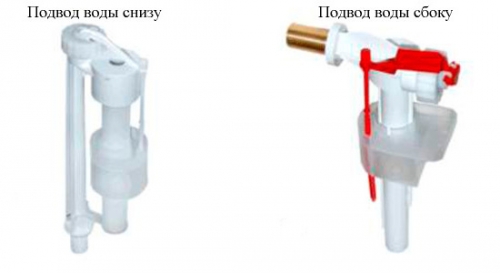
Suspended structures - another newfangled way to install toilets, which involves hanging the cistern at a certain height from the toilet bowl. A feature of this design is a strong water pressure, which guarantees efficient draining. However, it also has disadvantages, one of which is the excessive noise that is created in the process of draining water. Despite the presence of disadvantages, in general, such designs are considered one of the most practical and convenient, and their appearance will be an excellent addition to the interior, made in retro style.
The main types of triggers
The most common types of triggers are push-button and stem drain devices, which have proven to be one of the most reliable and durable systems. Push-button flush mechanisms are most relevant for closed cisterns. Their main element is a button, which can be located on the side of the drain bowl or in the center. There are single- and dual-mode push-button mechanisms. The latter implies the presence of two buttons: one of them drains the water completely, and the second half. A similar principle of the device will save water if such a need arises. A similar principle of operation of the drain device can also be implemented using one button, if the amount of drained water is determined by the degree of pressing the button.
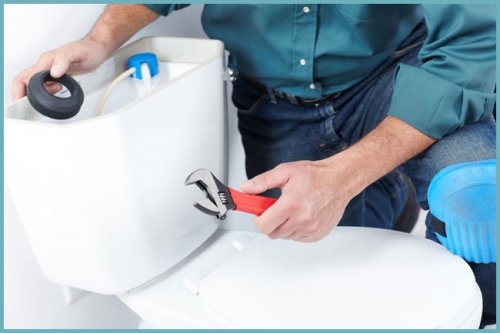
Drainage devices based on levers or chains are also gaining popularity. The manufacturer prefers to place such mechanisms in the side of the drain structure. To drain the water, just pull the lever or chain. This type of drain system will be most relevant for hanging toilets. In view of these features, the repair of a wall-hung toilet cistern will be somewhat different. Regardless of the type of installation of the drain tank chosen, there is a manual trigger mechanism, which involves manually setting the volume of drained water, and automatic.
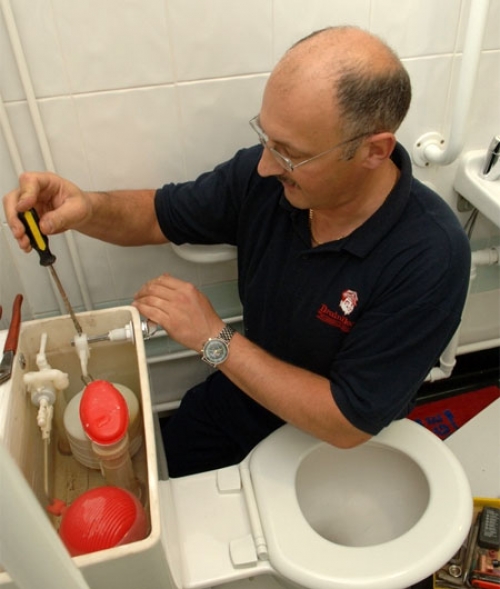
Features of the water collection system
There are several types of valves that regulate the flow of water:
- Lateral water supply, assuming the location of the fittings from above, is typical for sanitary equipment from Russian manufacturers. Despite the fact that plumbing equipment equipped with this mechanism is characterized by low cost, it is not in high demand, due to the rather noisy set of water. For models that are more expensive, it is typical to use a special pipe that reduces noise, which contributes to the supply of water directly to the bottom.
- The lower water supply is typical for models of both domestic and foreign manufacturers, belonging to a fairly high price category. Features of the mechanism of the lower water supply reduce the noise from the water to a minimum.

Drain tank device: basic elements
In order to correctly determine the causes of the malfunctions that have arisen and eliminate them in a timely manner, it is necessary, at least in general terms, to have an idea of \u200b\u200bthe internal structure of the drain tank. Despite the differences in the reinforcing structures of the drain tank, it is characterized by a single device scheme. The internal device of the drain tank implies the presence of the following elements:
- Shut-off or drain valves regulate the flow of water from the cistern into the toilet and prevent it from leaking unnecessarily. In the process of filling the tank, the water in it helps to firmly press the surface of the valve to the drain into the toilet, which stops the leakage of water. Thus, if the drain tank passes water, this is due to a malfunction of the valves;
- A filling valve, which is combined with a water supply device and designed to adjust the water level in the drain tank. When the water reaches a certain level, its supply to the tank stops. The water level indicator is a float connected to the filling valve by means of a brass rod. If the first models of drain devices assumed a lateral location of the filling valve and horizontal placement of the float, then modern plumbing models, while maintaining the traditional principle of operation, provide for the location of the filling valve at the bottom of the drain bowl, while the float is characterized by vertical placement;
Important! Problems leading to the need to repair the toilet cistern are most often associated with a malfunction of this particular mechanism and in most cases come down to its adjustment.
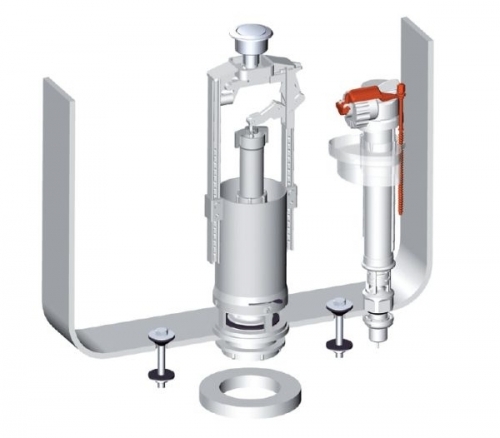
- The mechanism for draining and overflowing water, the design of which is represented by plastic fittings, equipped with start buttons. Its function is to prevent water from entering the room from the tank in the event of a malfunction of the float valve. The water overflow system, connected to the drain, comes into action after pressing the start button. Excess water is not poured out due to the connection of the drain mechanism with overflow devices, which contributes to the release of excess water into the sewer system. An important element of the system is a float valve connected to a float that regulates the water level in the tank. Malfunctions associated with the functioning of the float valve lead to water leaks from the tank.
Important! Each of these elements can become unusable, which will lead to the need for its repair. In this regard, there is no need to consider the problems associated with damage to the tank body, since in practice the elimination of cracks and chips in the body is practically impossible. This is due to the inefficiency of even the most modern adhesives, which is becoming the most common reason for replacing the toilet bowl.
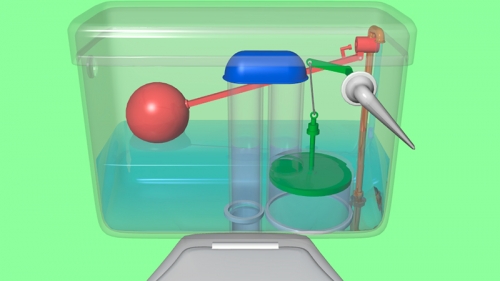
The most common malfunctions of the drain tank: methods for their elimination
Water leakage into the room: causes and methods for eliminating the breakdown
If you notice the appearance of water in the room, most likely the reason for this is a mounting problem. In this case, inexperienced homeowners are likely to panic and, thinking about replacing plumbing, will start looking for an answer to the question: “How to install a toilet bowl and avoid its breakdown during operation?”. But do not rush, this problem is easily fixed. Consider the most common causes of this malfunction:
- Deterioration of the sealing ring installed between the tank and the toilet bowl;
- Violation of the integrity of the gaskets of the mounting bolts.
All these malfunctions do not require complex diagnostics and can be detected even with a simple visual inspection. If you find these malfunctions, try to tighten the fasteners without applying excessive force, which can cause the tank to break or even violate its integrity.
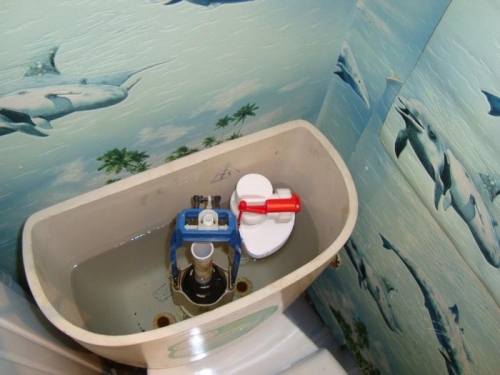
If you performed these manipulations, and they were unsuccessful, experts recommend removing the drain tank and replacing the rubber seal on the drain channel. They also recommend replacing the gaskets and washers on the mounting bolts.
Important! To increase the density of the joints, making them more reliable, experts recommend that they be additionally sealed with silicone.
What to do if water does not enter the tank?
This failure is also not uncommon, and its most common cause lies in the clogging of the narrowest part of the valve. Eliminating this problem will not cause difficulties - for this it is enough to release all the water from the tank and unscrew the valve along with the lever and float. After that, you will notice a fairly narrow hole designed for water to enter the tank. To eliminate its blockage, clean it with a needle or thin wire. Next, you need to slightly unscrew the valve on the inlet pipe and flush out the remnants of the blockage that has arisen. After making sure that water flows freely through the hole into the tank, tighten the valve and set the valve with lever and float to their original position.
Constant leakage of water from the tank into the toilet: causes and remedies for the breakdown
The causes of this malfunction may be:
- Distortion of the float lever;
How to eliminate? If you encounter this problem, it is enough to give the lever the optimal position for it.
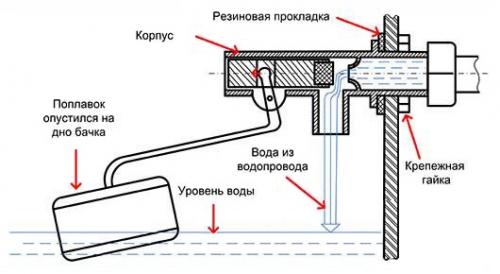
float damage, leading to the fact that he begins to pass water inside himself. This inevitably leads to its aspiration to the bottom of the tank tank, that is, the water that has got inside the float prevents it from returning to its original position, at which the flow of tap water is blocked. If this does not happen, excess water is discharged into the toilet through the overflow system.
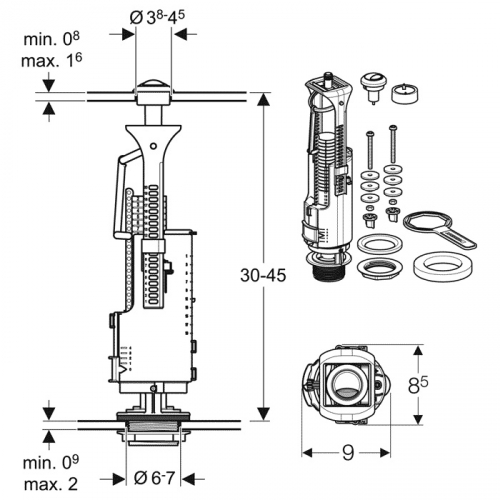
How to eliminate? The only possible option for effective repair, in this case, is to replace the part.
To do this, the water is blocked along the riser, the device is dismantled, and a new, pre-purchased similar part is put in its place.
Important! In order to repair the fittings of the toilet cistern as efficiently as possible, in the process of choosing it, experts recommend paying attention to the dimensions and design features of the parts, since some of them are not always interchangeable.
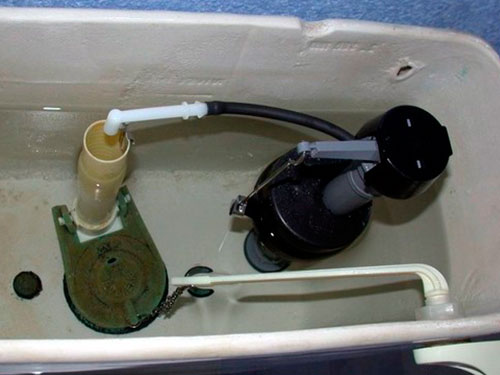
Important! In most cases, plastic or stainless steel is used to make modern floats. Floats made from these materials are practically not subject to leakage.
Wear of the sealing elements of the drain fittings. It is quite simple to find out whether the cause of the malfunction lies in the wear of the sealing elements. To do this, it is enough to slightly press the valve with your hand: if the water begins to flow, then you are not mistaken, the problem really lies in the wear of the shut-off valve, rubber gaskets or seal. You can fix this breakdown by replacing consumables.
Float wear can also cause permanent leaks. In this case, a hole is formed in the float, through which the outflow of water occurs.
Important! If you do not have the necessary parts on hand at the time of the problem, carry out a “temporary” repair. To do this, the hole formed in the float is sealed with heated plastic or the failed float is wrapped with a plastic bag, thereby sealing it. In this case, it is important not to forget to fix it around the float lever.
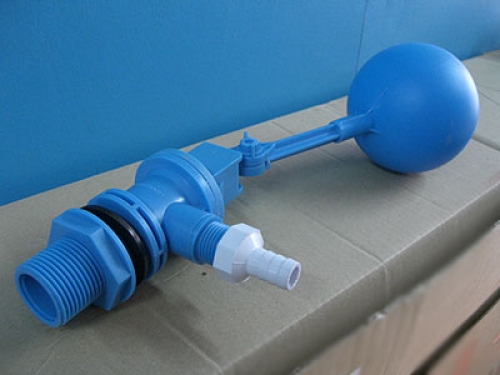
Repair of a toilet cistern with a button: procedure
How to remove the cover with one button?
- Loosen the retaining ring around the button. In this case, it is important to avoid strong pressure on it, since plastic is used in most cases for the manufacture of rings;
- Remove the cover and proceed with the repair.
As mentioned above, there can be several reasons for the constant leakage of water from the tank into the toilet:
- Incorrect position of the float - in this case, simply remove the toilet lid and adjust the float.
- Wear of the rubber bulb on the float valve, as a result of which it does not provide tightness.
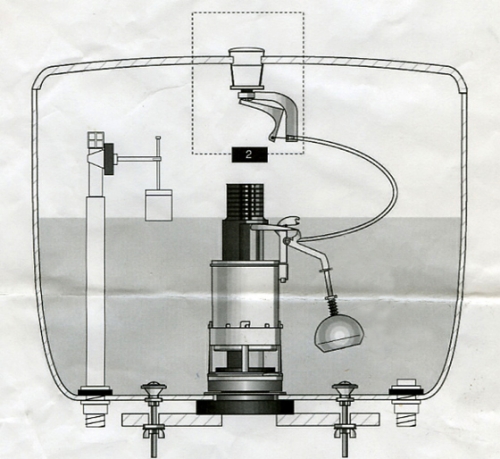
In this case, it is necessary to replace it. To do this, fix the float in the upper position and, by unscrewing the nut connecting the tank and the drain pipe, remove the entire mechanism;
- Remove the old pear, replacing it with a similar model with similar characteristics.
- If the bolts holding the pear are worn, they must be replaced.
- To do this, drain the water from the tank, removing its remnants;
- Unscrew the union nut located between the flexible hose and the float valve, as well as the bolts. With a little effort, tilt the tank with a shelf back, releasing the rubber cuff located between the tank and the toilet;
- Unscrew the damaged bolt, as well as its pair, and remove them. It is important to replace both bolts, even if the integrity of the second one is not yet broken. For replacement, select bolts of similar sizes made of brass or stainless steel;
- Remove the faience under the pear saddle and thoroughly clean it by doing the same with the shelf and tank. Lubricate the bulb with silicone sealant, which will later solve problems with its wear and prevent the need to replace it;
- After assembling the tank, tighten the structure with new bolts, while avoiding distortions. To prevent damage to fragile faience, do not apply excessive force during the assembly process;
- Turn on the water and fill the tank, carefully watching for leaks.
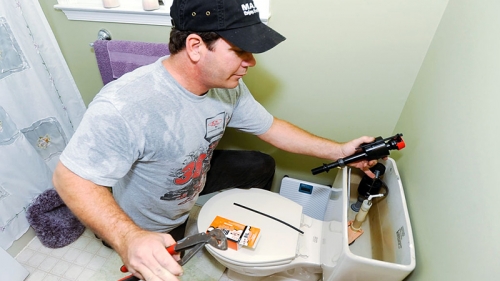
Failure of the descent lever: how to fix it?
How to determine that in your case we are talking about this particular malfunction? It's quite simple: if you press the flush button, but the drain does not start, this chapter will be useful to you.
The reason for such a malfunction lies in the violation of traction, and the only correct way out is to replace it.
Important! In this case, you can also make a "temporary repair" by making a thick wire rod and twisting it in several layers. However, improvised traction does not have a long service life - over time, the wire will begin to bend, which will also lead to its failure.
Before you start repairing the old toilet cistern in this case, loosen the button on the cistern lid. To do this, turn the decorative nut a few turns - in most cases this is enough to lift the cover, gaining access to the mechanism.
![]()
Noisy filling of the tank with water: how to eliminate?
Often, craftsmen have to face this problem, and this is especially true for owners of sanitary equipment, characterized by the presence of tanks with a side water supply. After a certain period of time, the capacity of the tank begins to fill with noise, which was not "at the dawn" of operation.
Most often, the cause of this malfunction is the disconnection of the water silencer, which is a special tube through which water is supplied to the lower part of the tank without any noise effects.
To eliminate this malfunction, put the muffler on a specially designed fitting.
Toilet cistern repair with button video


















